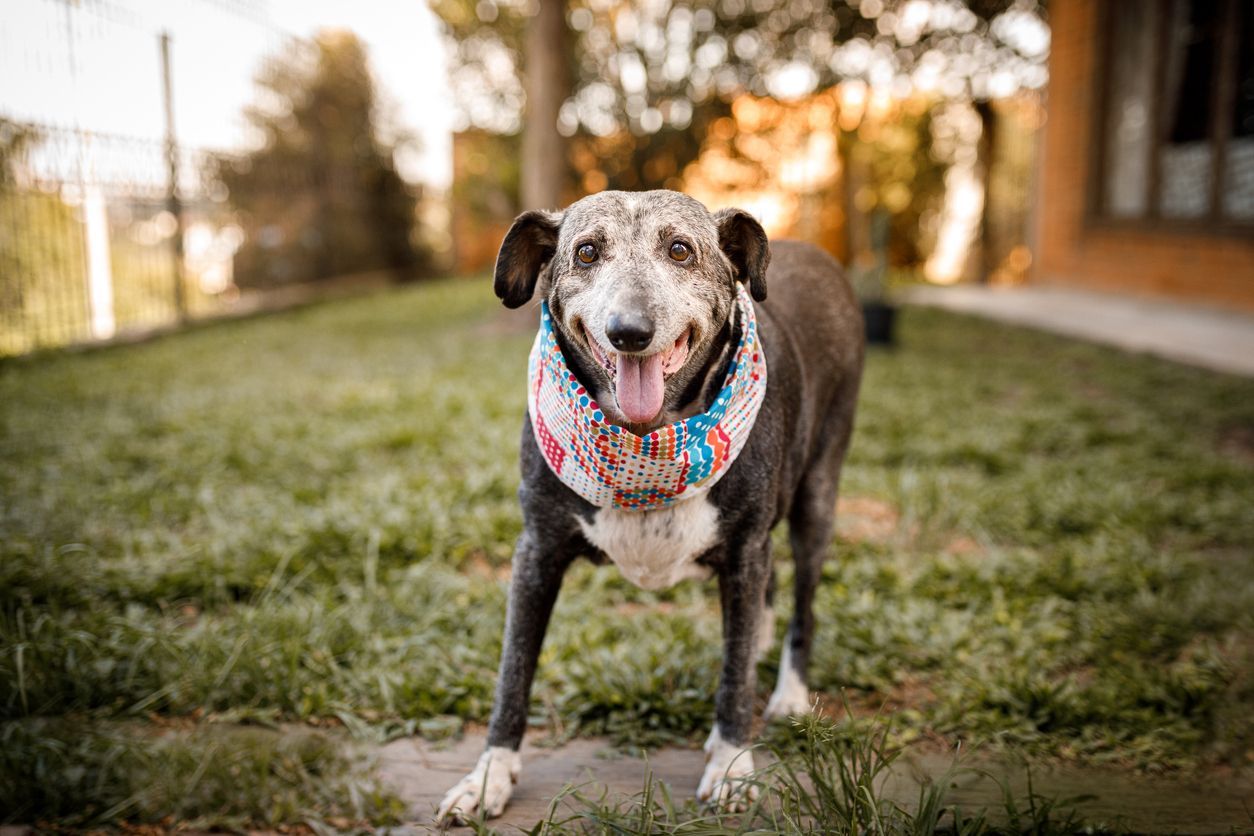Indoor and outdoor activities for your senior dog

Please note: this article contains affiliate links. We may receive compensation when you click on links and purchase products. There is no extra charge to you, and all products listed are veterinarian-approved.
Physical and mental exercise remains important when our dogs become older. However, their exercise and play may look a little different as their bodies change. Read on to learn:
- Why does my senior dog need daily exercise and mental stimulation?
- What outdoor exercises and activities will my senior dog like?
- Can indoor dog activities provide my senior with exercise?
- How will exercise needs change as my dog gets older?
Physical activity and mental stimulation are important for a dog’s quality of life, no matter what age they are. There are many ways to get creative, both indoors and outdoors, to provide exercise and play with your senior dog in a safe way.
Why are physical exercise and mental stimulation good for senior dogs?
Just like other adult dogs, seniors still require physical activity and mental stimulation to remain happy and healthy. Regular exercise also helps limit the risk of obesity and maintain a healthy weight and condition in senior dogs. Keeping the mind active with mental exercises and toys can help provide enrichment as well as potentially slow the onset of canine dementia.
What are the best outdoor activities for my senior dog?
Even if they are starting to slow down, our older furry friends still enjoy being outdoors in the fresh air. In addition to providing exercise, fun activities outdoors can improve the mental health of senior dogs by allowing them to explore new sights and smells.
Swimming
Swimming is an excellent activity that provides low impact exercise for senior dogs. Floating in water can help relieve pressure on painful or stiff joints and provides relief during the hot summer months. If your senior dog struggles to swim, a canine life jacket can help ease the effort required. Always keep a close eye on your dog and help them exit the water before they show signs of tiring out.
Gentle walks and picnics
Seniors may still enjoy regular walks outside. As your senior dog starts to lose agility, allow them to set the pace of the walk. Many senior dogs prefer multiple, shorter walks over the course of the day over one or two longer excursions. Senior dogs are also more sensitive to hot weather, so avoid walking outside during the hottest part of the day in the summer months.
Dogs may also enjoy a slow walk to the park or on a non-strenuous trail for a picnic. This allows them to rest and lie down while still enjoying the sights, sounds, and smells of a new place and also lets them snack on some healthy treats.
Outdoor scavenger hunt
Allowing a dog to utilize their hunting instincts helps provide a physical and mental workout. Try hiding treats around the yard or scattering treat-filled paper towel tubes for a self-paced, fun game. Scavenger hunts can be set up indoors as well.
Senior dog meetups or dog parks
In some areas, there are senior dog groups that gather on a regular basis to allow their older dogs to socialize and play without worrying about injuries from attempting to keep up with younger dogs. Some dog parks also cater to senior dogs or dogs with special needs to provide gentle play. These locations will help provide socialization, mental enrichment, and physical exercise while limiting overexertion or injury from younger dogs.
What are the best indoor activities for my senior dog?
When the weather is unpleasant or if you simply want to provide some entertainment and enrichment for your dog inside, there are many fun activities suitable for older dogs.
A puzzle toy or snuffle mat
Puzzle toys and games help provide mental stimulation as dogs work to solve the puzzle to find and earn treats hidden inside. Some of these puzzles also provide physical activity by encouraging movement. Similarly, snuffle mats also involve finding treats. Instead of solving puzzles, dogs search through mats with various textures and types of fabric to find their tasty snacks. These mats provide mental stimulation as well as offer new sensory experiences.
If you think a puzzle toy or snuffle mat is right for your furry friend, check out our curated, vet-approved list. There are also dozens of options for making your own at home.
Dog yoga and massage
Many dogs may be curious and want to participate in yoga with you at home. Dog yoga, or “doga,” can provide slow movement and stretches for seniors who may be struggling with joint pain. Actively stretching and massaging your dog’s muscles and joints can also alleviate pain and swelling. If you have a dog with arthritis or another joint disease, talk to a vet about physical therapy stretches and massage that may help your aging pet. Making the stretches and massage into a fun game can help your dog enjoy it even more.
Fetch with soft toys
Old age does not necessarily mean a dog won’t enjoy a classic game of fetch anymore. Soft toys and balls instead of tennis balls may be more comfortable for dogs recovering from treatment for dental issues. To further help an older dog that may be experiencing bodily discomfort, roll or toss the toys at a closer distance to avoid strenuous running and jumping.
Trick and obedience training
Old dogs can definitely still learn new tricks. Practice old commands and slowly add in a few new ones to provide simple exercise and mental stimulation. Go at a slow pace and avoid tricks that may put excessive pressure on the joints or muscles. Offer plenty of positive reinforcement with praise and treats to make it an even better experience for your elderly pooch.
What types of activities should I avoid with my senior dog?
Avoid using stairs, excessive running, jumping, or other activities that put stress on the joints. Osteoarthritis is diagnosed in about 20% of dogs, many of them in their senior years. Avoiding additional joint stress can help keep a dog comfortable and happy. Rough play with other dogs can also put strain on a senior, causing injury or overexertion.

“When playing or walking outdoors, have a plan to return home right away if your dog starts to get tired,” advises Dr. Jo Myers, a veterinarian at Vetster. “It’s better to get home before tiredness sets in to avoid overexertion.” Bringing a carrier, sling, or other support can help a tired or sore dog get back home.
Final tips for senior dog play
Every dog is unique and will have different physical constraints on what they can and cannot do safely as they age. To help keep your dog safe:
- Let your dog set the pace
- Stop the activity right away if they appear tired, stiff, or sore
- Keep an eye out for stiffness or soreness after exercise
If a dog appears stiff after exercising, the activity is likely too strenuous. Adjust the activity as needed to keep it safe as well as fun. If you notice changes in your dog’s demeanor or appearance after an activity, reach out to a vet for advice.
Every dog has a unique medical history as well as different likes and dislikes. Finding a balance between what is safe for your senior dog and what is enjoyable for them can be difficult. A virtual vet appointment can allow you to discuss your dog’s individual physical activity needs and constraints without the stress of visiting a veterinary office.
FAQ - Indoor and outdoor activities for your senior dog
How do you mentally stimulate an old dog?
Old dogs can still enjoy puzzles, obedience training, and soft toys both inside and outside. Allow your senior dog to set their own pace. Provide toys and hidden treats to allow them to explore for mental and physical enrichment. Rotate toys frequently so your dog can benefit from new challenges.
How much exercise should a senior dog get?
Dogs, in general, need 30 to 60 minutes of exercise every day. Senior dogs are no exception, but their exercise may look different compared to a younger dog. Allow your senior to set the pace on slow walks, swims, and soft play. Avoid outdoor activities in hot weather as seniors are more susceptible to heat-related illness and exhaustion.
Should you walk senior dogs?
Older dogs may still enjoy regular walks. To prevent overexertion, allow them to set the pace and follow their lead. For dogs with joint problems, staying close to home or having a plan to rest or bring them home right away will help prevent strain and joint soreness. Some senior dogs prefer multiple shorter walks during the day instead of one or two longer excursions.
What is the best exercise for older dogs?
Slow walks, swimming with a life jacket, and fetch with soft toys are great ways to exercise an older dog. Always remember to allow them to set the pace and pay close attention to their energy levels. If they appear tired or sore at all, it’s time to stop the activity. If your dog is unusually sore when getting up from a nap following exercise, that’s a clue that you did too much.




